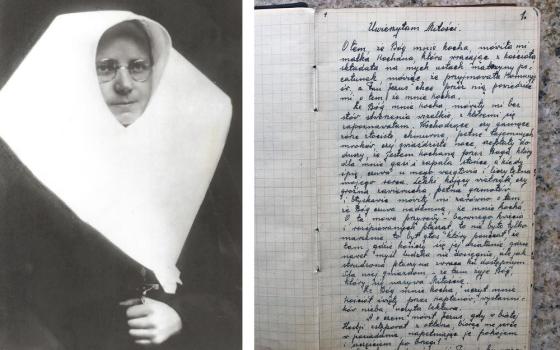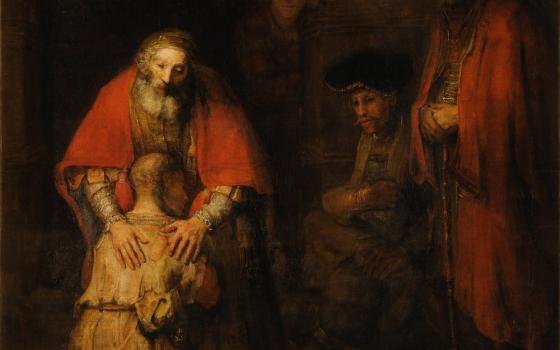The 2009 book Holiness and the Feminine Spirit: The Art of Janet McKenzie, edited by Susan Perry, features McKenzie’s religious art accompanied by essays by noted contemporary women writers. In the following excerpt, Boston College theologian M. Shawn Copeland reflects on the life of St. Josephine Bakhita, a Canossian Daughter of Charity, who is depicted in a portrait by McKenzie.
On Oct. 1, 2000, John Paul II canonized Josephine Bakhita, a Sudanese woman, freed slave, Canossian Daughter of Charity, “flower of the African desert,” “patron of Sudan,” and, by her own self-designation, “a daughter of God.” Janet McKenzie’s oil painting of Bakhita suggests a sentry, a woman composed, fiercely and lovingly guarding the children of her native Darfur. While her biographer focuses on Bakhita’s practice of the virtues of humility and meekness, McKenzie depicts courage, fortitude and hope -- virtues Bakhita surely needed throughout her life.
What we know of Josephine Bakhita’s early life comes from the story that she dictated in 1910 at the direction of her religious superiors to relate “some events of her time in slavery.” This document, held in the Canossian Archives in Rome, may well be the only extant slave narrative by a Roman Catholic. Bakhita was born in 1869 a member of the Dagiu people in Darfur, western Sudan. She described her family -- father, mother, three brothers, and three sisters -- as happy, reasonably prosperous, and well respected in their village of Olgossa. Her father owned sizable herds of cattle and sheep as well as fields that were cultivated by hired help. The Dagiu people are reputed to be peaceful and hard-working, but then, as now, they and all the indigenous peoples of Sudan faced precarious circumstances.
The medieval Arab geographers charted Darfur as part of the Sahel or bilad al-Sudan (the land of the blacks). Today the people of the region share a complex heritage derived from commercial, social, cultural and religious encounters among tribes of Africans and Arabs. To outsiders all the people of Darfur appear racially identical, but ethnic distinctions set them apart from one another and stoke enmities rooted in ancient rivalries. Little is known with certainty about the peoples of Sudan until the 17th-century emergence of Suleiman and his quest for territorial expansion and trade, especially in ivory and black slaves. But it is likely that well before the 16th century the peoples of western Sudan had been prey to aggressive slave-raiding by Egyptian, northern Sudanese, and Arab traders. É
Young children and women were specific targets of trans-Saharan slave-raiding and trade. Young girls and women were sold for domestic use (for agriculture, cleaning, cooking, cloth-weaving), concubinage, and often both, as male slaveholders could claim the right to use them sexually. Some young boys were pressed into the military, but many were castrated for service in harems or in mosques.
When Bakhita was 5 or 6 years of age, slave raiders kidnapped her eldest sister. Three years later, while Bakhita was strolling outside the village with a friend, two Arabs used deception to separate her from her companion and then kidnap her. Threats and rough treatment so traumatized the little girl that she was unable to shout for help and could not speak her own name when questioned. With mocking irony, the men named her “Bakhita” (fortunate or lucky one), a common appellation for female slaves.
After a day’s march, the men locked Bakhita in a dark hut for more than a month and then sold her to a trader. Between 1876 and 1882, Bakhita was sold to three different masters, including a general in the Turkish army. The last slaveholder, albeit benign, was the Italian vice consul Callisto Legnani. During the two years that Bakhita was held in the vice consul’s household, the political situation in Darfur deteriorated as the people rebelled against the “corrupt, increasingly arbitrary” rule of Egypt.
 Finally in 1881 Muhammad Ahmad Abdallah declared himself to be the Mahdi, “the divinely guided one” of Sunni Islamic belief, “who would restore justice, unite Muslims, and signal the end of the world.” The impending arrival of the Mahdi and his army forced Vice Consul Legnani to leave Khartoum. Bakhita first requested and then insisted that she be allowed to accompany him to Italy, hoping for a new life, but upon their arrival in Genoa, Legnani gave her as a gift to a friend, Venetian merchant Augusto Michieli.
Finally in 1881 Muhammad Ahmad Abdallah declared himself to be the Mahdi, “the divinely guided one” of Sunni Islamic belief, “who would restore justice, unite Muslims, and signal the end of the world.” The impending arrival of the Mahdi and his army forced Vice Consul Legnani to leave Khartoum. Bakhita first requested and then insisted that she be allowed to accompany him to Italy, hoping for a new life, but upon their arrival in Genoa, Legnani gave her as a gift to a friend, Venetian merchant Augusto Michieli.
Michieli and his wife, Maria Turina Michieli, took Bakhita to their hotel in Zianigo in northeast Italy. The adolescent girl adapted to her duties and took on the care of the Michieli’s daughter, Alice. A few years later, Mr. Michieli returned to the Red Sea port city of Suakin in Sudan, where Venetian merchants conducted business. There Michieli purchased a luxury hotel and planned to relocate his family and Bakhita. Mrs. Michieli traveled to Suakin in order to clarify the terms of sale of their property in Zianigo. Prior to her departure, she directed Illuminato Checchini, the manager of their hotel, to place Alice and Bakhita with the Institute for Catechumens run by the Canossian Sisters.
Bakhita found a true friend in Checchini. Once, while in his home, she discovered a crucifix; gazing at it intently she wondered: “Who are you? Why have they put you on the cross?” The manager told her about Jesus Christ, the son of God. While her poor command of Venetian (Italian) and her lack of religious background may have hindered the depth of Bakhita’s understanding, she knew the pain of the lash, of beatings, of abuse. She too was a person of sorrow, despised, and rejected.
Checchini gave Bakhita a silver crucifix. “As he gave it to me,” Bakhita said, “he kissed it with devotion. I looked at it almost secretly, was filled with a mysterious force and felt something inside me that I could not understand.” Almost immediately, Bakhita expressed her desire to become a Christian. For nine months, she was nurtured and enjoyed the solace of the catechumenate where she “came to know the God whom I had felt in my heart since I was a child without knowing who he was.”
But this time of joy and consolation was interrupted with the arrival of Mrs. Michieli, who demanded the return of her slave Bakhita to accompany her to Sudan. The young woman refused to comply, thereby provoking a legal and religious crisis. For her the institute had become a physical and emotional sanctuary and also a place of prayer and contemplation. With the legal assurance that on Italian soil she was a free person, Bakhita recalls that she fixed her eyes on a crucifix on the wall in front of her and declared, “I can’t leave this place because I don’t want to lose God.” On Jan. 9, 1890, Bakhita was baptized Josephine Margaret Maria Bakhita, received Communion, and was confirmed.
Six years later, at the age of 30, after three years of religious formation, Josephine Bakhita made her profession of vows as a member of the Canossian Daughters of Charity. She lived and worked at the institute until 1902, when she was transferred to a Canossian house in Schio, where she carried out various domestic duties.
Her biographer comments that people from all walks of life and of all ages were attracted to her goodness. Through prayer, she devoted herself to the welfare of her African brothers and sisters as well as to all who crossed her path. Throughout her adult life she demonstrated only sympathy and forgiveness toward her former captors and oppressors and prayed for them continually.
During World War II, Schio endured heavy bombing, but the people suffered no casualties. The townspeople of Schio admired Bakhita, respected her, relied on her listening ear, advice, and counsel, indeed, her very presence. They believed that her prayers and intercession protected them from harm. ...
In 1943, after 50 years in religious life, Bakhita’s health began to decline; she was diagnosed with arthritis, asthma and bronchitis. As her body weakened and twisted with pain, her strength diminished and even walking with a cane grew difficult. Bakhita began to use a wheelchair, and when she could no longer use it alone, she asked to be pushed to the chapel. There she spent hours in prayer “look[ing] from the tabernacle to the crucifix.” It seems that perhaps Bakhita gave herself over to the awe she experienced as a child. She tells us that from an early age she was drawn to the beauty and mystery of nature -- the rising and setting of the sun, the bright night stars, flowers and plants of all kinds. Often she asked herself, “Oh who is the Master of all these beautiful things? How I would like to meet him and pay him homage!”
Josephine Bakhita contracted severe pneumonia in February 1947. When one of the sisters inquired about her condition, Bakhita replied:
I’m going slowly, slowly towards eternity. ... I’m going with two suitcases: one contains my sins and the other, which is much heavier, contains the infinite merits of Jesus Christ. When I appear before the judgment seat of God, I will cover my ugly suitcase with the merits of Jesus and Our Lady and I will say to our eternal Father: “Now judge what you see.” Oh, I’m sure I won’t be sent away! Then I’ll turn toward St. Peter and I’ll say to him: “Close the door because I’m staying here.” Josephine Bakhita died on the evening of Saturday, Feb. 8, 1947.
Despite an obscure life, Josephine Bakhita has captured the imagination of millions. She is venerated as the patron of Sudan, and her story evokes the ongoing suffering of women and children in contemporary Darfur. The people of Schio claim her as their own and African-American Catholics have embraced her. É
During her final illness, she assured the sisters who stood around her bed: “Don’t be sad, I’ll still be with you. If the Lord allows me to, I’ll send many graces from heaven for the salvation of souls.” Janet McKenzie’s “Bakhita” radiates the courage and confidence of that promise.
[Excerpted with permission from Holiness and the Feminine Spirit: The Art of Janet McKenzie. Art copyright 2009 by Janet McKenzie (www.janetmckenzie.com). Text copyright 2009 by Orbis Books (www.orbisbooks.com) on behalf of the author.]


